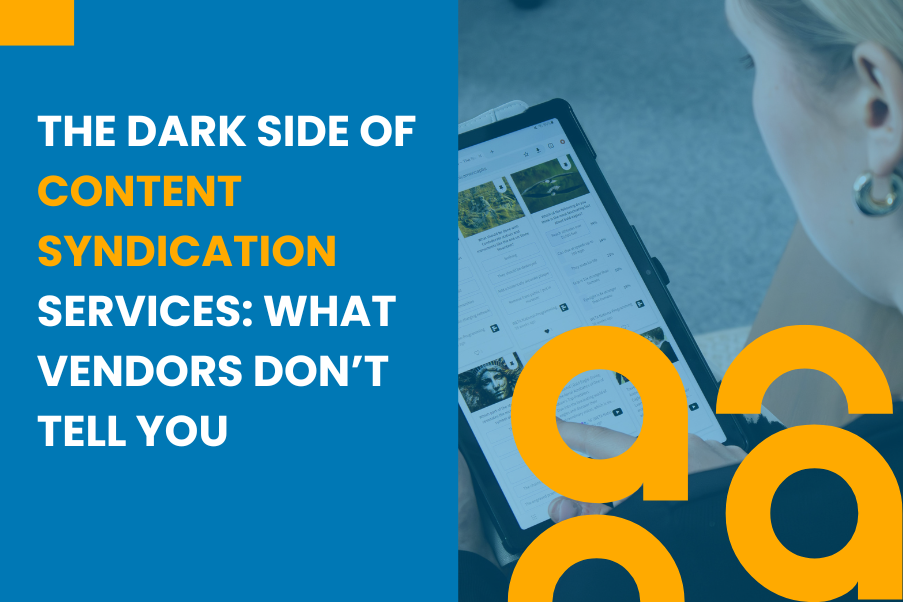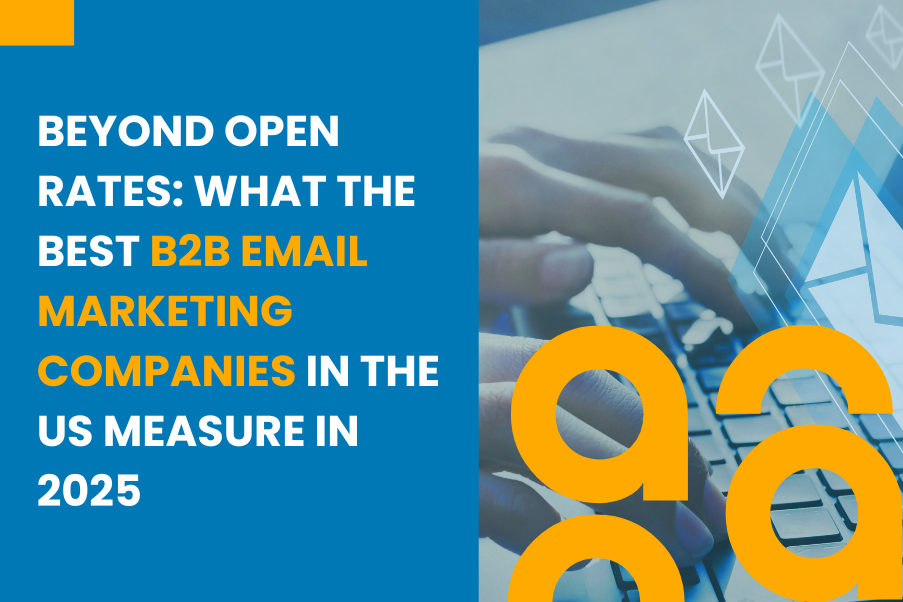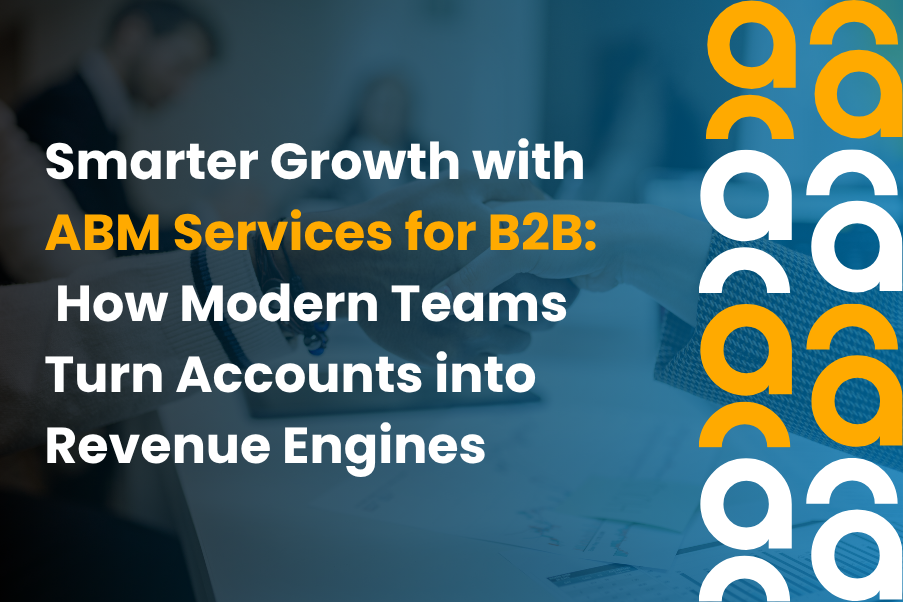The Dark Side of Content Syndication Services: What Vendors Don’t Tell You

Introduction
If you’re handing over your marketing budget to a content syndication vendor just because they promise thousands of “leads,” you may be walking into a trap. Many providers recycle stale databases, prioritize vanity metrics, or hide costs behind opaque contracts. Stop trusting numbers at face value.
In this blog, we’ll reveal the risks of content syndication services, show how to spot red flags, and explain how to vet vendors who actually deliver pipeline, not just presentations.
What Are Content Syndication Services and Why Do They Attract Marketers
You already know what content syndication services do: they republish or distribute your content across third-party websites or through networks to widen reach. On the surface, this model seems like an easy way to get in front of more prospects.
To set the context, here’s a reminder of how does b2b content syndication works. A vendor takes your assets – whitepapers, reports, ebooks – and places them on resource hubs, email blasts, or aggregator platforms. Interested users download the asset in exchange for their contact details. The vendor then shares those contacts as leads with you.
Because the promise is scale and speed, these services often look like a quick win for marketers under pressure to deliver results. But that quick win is exactly what some providers exploit.
Risk #1: Recycled Leads and Database Reuse
One of the most common issues with content syndication services is recycled contacts. Some vendors resell the same lead to multiple clients. Worse, you might end up paying for leads already in your CRM or for individuals who have been approached by competing brands.
- 48% of B2B marketers report lead quality, not volume, as their biggest concern with syndication.
- At the same time, 30% of B2B firms consider content syndication one of their top lead engines, but that doesn’t confirm if those leads are net-new or relevant.
Recycled data frustrates sales teams, damages credibility, and wastes resources.
Solution: Demand exclusivity guarantees. Reliable b2b content syndication platforms will commit to delivering unique, verified leads that haven’t been sold elsewhere. Cross-check every new list against your existing CRM and set rules for immediate replacement if duplicates appear.
Risk #2: Vanity Metrics vs. Real Pipeline
Another pitfall of content syndication services is the reliance on vanity metrics. Some vendors report the number of impressions or downloads, creating the illusion of success. But without context, these numbers mean little. A thousand downloads don’t matter if the audience is outside your target market.
- According to MarketingSherpa, top-performing marketers achieve 5.31% conversion on syndicated content. The average cost per lead is around $43, showing how quickly budgets can rise if quality isn’t managed.
A content syndication vendors that prioritizes volume often overlooks how many B2B content syndication leads actually progress into MQLs or SQLs.
Solution: Measure success based on outcomes, not activity. Set KPIs around progression rates, not downloads. Insist on reports that track lead-to-pipeline contribution. A vendor unwilling to discuss deeper funnel results likely lacks transparency.
Risk #3: SEO Cannibalization and Duplicate Content
Syndicating content means republishing it across different websites. While this expands reach, it also creates risks for your search engine rankings. If a syndicated version gets indexed before your original, your own site may lose traffic.
- Evidence shows that syndicated content can cannibalize organic traffic if proper technical measures are not in place.
- Without canonical tags, Google considers your version a duplicate, hurting visibility.
This is especially critical when working with large b2b content syndication platforms that distribute across many sites at once.
Solution: Request SEO safeguards as part of your contract. Vendors must apply canonical tags and attribution linking back to your original asset. Ask for proof of their process and review existing b2b content syndication examples to confirm compliance before approving campaigns.
Risk #4: Hidden Costs and Contract Traps
A frequent complaint about B2B content syndication services is unexpected costs. Vendors may charge additional fees for “premium” targeting, filters, or verification. Some enforce strict contracts with penalties for early termination, leaving clients locked into underperforming programs.
Hidden costs erode ROI and complicate budgeting. The risk multiplies when providers structure their pricing to appear attractive at first glance but escalate after add-ons.
Solution: Ask for transparency upfront. Get a complete cost breakdown that includes targeting, data validation, and reporting. Negotiate flexible, pilot-first agreements rather than long lock-ins. This protects your budget and gives you leverage if performance does not meet expectations.
Risk #5: Compliance Blind Spots and Data Privacy
With data privacy laws like GDPR and CCPA, compliance is more than a checkbox – it’s a business safeguard. Unfortunately, some vendors still rely on outdated or unclear consent mechanisms. If your vendor fails to capture user consent properly, your company bears the liability.
- A McKinsey study found that 87% of consumers avoid companies that mishandle data privacy.
Poor compliance risks fines and damages your reputation. The responsibility for handling personal data ultimately falls on you, even if the vendor was at fault.
Solution: Require documentation of consent collection. Trusted vendors will provide proof of how each lead opted in. If a partner cannot demonstrate compliance, treat that as grounds to reconsider.
How to Spot a Reliable Partner
Despite the risks, content syndication services can still work if you choose the right partner. Look for these qualities:
- Proof that all leads are unique and net-new.
- Transparency on data collection and consent logs.
- Lead-level detail instead of aggregated numbers.
- Conversion-focused reporting that tracks progress to MQL and SQL.
- Correct SEO practices, including canonical tags.
- Audit and exit options in contracts.
- Flexible targeting filters to align with your ICP.
- Option to pilot before scaling.
Checking real b2b content syndication examples shared by the vendor can also help validate their credibility. If they only highlight flashy numbers without client success stories, be cautious.
Why Strategy Matters
Content syndication is not a one-off tactic. The right b2b content syndication strategies combine syndication with segmentation, nurturing, and sales alignment. Leads must flow into a nurture program, not straight into cold sales calls.
Marketers who invest in strategy see stronger outcomes because campaigns are designed to match the buyer’s journey instead of relying solely on downloads.
A Transparent Approach: Our Services
At Almoh Media, we deliver content syndication services that avoid the pitfalls above. Our approach includes:
- Targeting that matters: Every campaign is aligned with your Ideal Customer Profile. We filter by industry, company size, job roles, geography, and technographics so that the leads you receive are a true fit for your business.
- Verified, fresh data: Through de-duplication and multi-step verification, we guarantee that every lead delivered is new, accurate, and relevant, reducing wasted sales effort.
- Transparency at every level: You gain full access to lead-level data, not just surface reports. This allows your team to validate, segment, and act on information with confidence.
- Global compliance first: We adhere to GDPR, CCPA, and other privacy regulations, ensuring every lead has been sourced ethically and with documented consent.
- SEO-safe practices: By applying canonical tags and attribution, we make sure syndication supports your visibility instead of competing with your own assets.
- Reporting that drives action: Our reports track the entire funnel, connecting leads to MQLs, SQLs, and pipeline contribution, so you always see real outcomes.
- Flexibility you can trust: We believe in pilot-first engagements. No hidden fees, no forced long-term lock-ins; just results that prove themselves before you scale.
With this approach, we position content syndication services as a channel that delivers measurable, sustainable value instead of empty promises.
Conclusion
Content syndication services can either support pipeline growth or drain budgets, depending on the partner you choose. Risks include recycled leads, vanity metrics, SEO loss, hidden costs, and compliance risks. But with the right due diligence, careful strategy, and trusted vendor, these campaigns can still be a valuable part of your demand generation mix.
If you feel your current vendor may be overpromising and underdelivering, reach out to Almoh Media. We’ll show you how to run content syndication services with transparency, compliance, and results you can measure.
Let us help you turn syndication into a channel that truly builds a pipeline. Contact us today.
Introduction
If you’re using content syndication, chances are you see it as just another way to get your content in front of more eyes. That’s fine, but there’s a lot more hidden beneath the surface. When you allow its full potential, content syndication ROI can surprise you, and it doesn’t take much to shift perception.
Let’s look at fresh data, outline a winning content syndication strategy, and show how U.S. B2B teams can get real value from it. Let’s begin!
What Is Content Syndication?
At its simplest, content syndication means sharing your B2B content: whitepapers, case studies, blogs on someone else’s site or network. This can be paid or free. You expand your reach, tap into new networks, and generate visibility, often reaching audiences you’d otherwise miss.
Why ROI From Content Syndication Deserves a Second Look
1. Huge lead production for relatively low spend
According to recent studies, the average cost per lead with content syndication is around $43. That’s far lower than other tactics, so even moderate conversion rates can offer solid returns.
2. Fast pipeline growth
Some platforms report that customers see 300–500% return on investment within three years. That’s not fluff – it’s real pipeline growth.
3. Verified conversion tracking methods
With UTM tagging and targeted vendor reports, U.S. marketers can track everything from initial syndication click to closed deal.
4. Built-in trust and positioning
Syndicating through known sites can give you indirect credibility, boosting brand awareness and authority without extra effort.
B2B Content Syndication Strategy: How to Do It Right
A good content syndication strategy starts long before content hits a third-party platform:
a). Pick assets that matter
Whitepapers, case studies, and long-form guides work best. They not only attract interest but also help establish your brand as industry-relevant.
b). Target lead quality, not rush volume
Instead of chasing clicks, target professionals. For example, top B2B firms average a 5.31% conversion rate on syndication offers.
c). Tag everything with UTM links
Measure traffic, engagement, bounce rates, and conversions back at your URL. This helps with syndication attribution.
d). Track core metrics
- CPL (cost per lead)
- MQL-to-SQL conversion rates
- Revenue per lead (use your average contract value)
e). Use the ROI formula
ROI= Revenue−Spend
Spend
For example, $1,000 spent → 50 high-quality leads → $5,000 average value = ($250k – $1k)/$1k = 249× ROI.
f). Optimize, rinse, repeat
Check what works by audience, site, and format. Then double down and drop what doesn’t.
Concrete U.S. ROI Stats You Can’t Ignore
| Metric | Statistics/Insight |
| Cost per lead | $43 average CPL |
| Syndication conversion rate | ~5.31% typical |
| Lead-to-deal conversion lift | 45% increase when focus is on quality |
| ROI over 3 years | 300%–500% reported |
| Projected industry growth | From $4.7 B in 2022 to $5.9 B by 2030 |
Content Syndication for Lead Gen: A Step‑by‑Step Plan
1. Define your ideal audience
Use buyer personas: titles, sectors, company size – so your content finds the right hands. This way, a sharper audience focus helps eliminate wasted spend and improves downstream lead quality.
2. Pick content with substance
Original research, how-to guides, competitive whitepapers – these both educate and convert. Plus, assets that solve specific problems tend to drive stronger engagement and more intent-driven leads.
3. Choose partners wisely
Use third-party platforms to reach U.S. B2B audiences. Look for those offering clear lead reporting and media kits. Before moving forward, ask for case studies or past performance metrics to make a more informed decision.
4. Structure campaigns with UTM tags
Make distinct tracking links for each partner and asset. This makes sure it’s easier to attribute leads, identify top performers, and compare ROI across channels.
5. Launch and monitor
Track CPL, CPL-to-SQL, cost per opportunity, pipeline driven, and revenue tied. At the same time, monitor activity in real-time to catch early trends and shift strategy fast if needed.
6. Review and refine monthly
Use metrics to shift spend toward top performers and tweak underperformers. As a result, consistent optimization keeps your syndication efforts aligned with revenue goals, not just vanity metrics.
How to Calculate Content Syndication ROI
- Calculate total spend (vendor fees + internal costs).
- Count total leads.
- Multiply leads by average deal size for potential revenue.
- Apply the ROI formula:
Revenue−Spend
Spend - Compare ROI over time to benchmark your initiatives.
This method is backed by multiple calculators and case studies.
Hidden Content Syndication Benefits
- SEO gains: Backlinks from quality sources can raise domain authority.
- Brand authority: Recognition on respected sites = credibility.
- Extended content life: A blog post can live on for months if syndicated well.
- Nurture acceleration: Leads from syndication are often further along in buying cycles.
Mistakes to Avoid and Fix Fast
Mistake: Only tracking clicks, not deals.
Fix: Tie every lead back to conversions with CRM integration. That way, you get a clearer picture of what’s actually driving revenue, not just traffic.
Mistake: Focusing only on cheap volume.
Fix: Go after quality; MQL-to-SQL rates matter most. Otherwise, your sales team will waste time on leads that won’t convert.
Mistake: Publishing irrelevant content.
Fix: Audit content – ensure tone, relevancy, and depth match syndication partner audiences. In doing so, you increase the chances of your content resonating with the right decision-makers.
Mistake: Not optimizing over time.
Fix: Regular performance review. Cut poor performers, boost winners. Over time, this helps improve ROI and keeps your content syndication strategy focused and results-driven.
Why Lead Quality Beats Volume
Not all leads are created equal. A smaller batch of high-intent leads can drive more revenue than a huge pool of low-interest ones.
Many B2B brands in the USA are shifting toward account- based syndication, where campaigns are matched to specific industries or companies. This helps improve conversion rates, shorten sales cycles, and increase customer lifetime value.
In short, prioritizing lead quality helps improve the long-term content syndication ROI, especially when targeting high-ticket accounts.
How AI Is Shaping the Future of Syndication
AI tools are starting to reshape content syndication strategy by analyzing behavior patterns and automating placements across high-performing channels.
With predictive scoring, marketers can now:
- Match content formats to individual user segments
- Forecast lead readiness using engagement scores
- Automate syndication at scale using content intent data
These innovations are raising the ceiling on what’s possible for B2B content syndication, especially for companies focused on measurable results.
About Almoh Media
Use metrics to shift spend toward top performers and tweak underperformers.
As a result, consistent optimization keeps your syndication efforts aligned with revenue goals, not just vanity metrics.
At Almoh Media, we specialize in high-impact content syndication for lead gen. We help B2B companies in the U.S. grow their pipelines by delivering:
- Verified lead generation from trusted channels
- Industry-specific targeting and campaign setup
- Transparent reporting tied to your sales funnel
- A proven strategy backed by real ROI
We understand the U.S. B2B buyer journey, and our syndication campaigns are built to generate demand, not just clicks.
Final Takeaway
Content syndication is an easy win if done smartly.
Focus on:
- Quality, not just volume
- Clear tracking and attribution
- Lead-to-deal conversions
- Continuous optimization
With $43 CPL, 5+ percent conversion, and long-term returns of 300–500%, most U.S. B2B teams can justify putting more budget behind it.
Ready to Get Real ROI from Content Syndication?
Let Almoh Media help you build a smarter lead-gen machine. We bring strategy, scale, and precision to content syndication – so your campaigns don’t just get seen; they convert. Reach out now to get started.
-
 The Dark Side of Content Syndication Services: What Vendors Don’t Tell You
The Dark Side of Content Syndication Services: What Vendors Don’t Tell You -
 Beyond Open Rates: What the Best B2B Email Marketing Companies in the US Measure in 2025
Beyond Open Rates: What the Best B2B Email Marketing Companies in the US Measure in 2025 -
 Why Content Syndication Companies Are the Hidden Growth Engine for Media Agencies
Why Content Syndication Companies Are the Hidden Growth Engine for Media Agencies -
 How the Right B2B Content Syndication Service Provider Elevates Your ABM Campaigns
How the Right B2B Content Syndication Service Provider Elevates Your ABM Campaigns -
 Smarter Growth with ABM Services for B2B: How Modern Teams Turn Accounts into Revenue Engines
Smarter Growth with ABM Services for B2B: How Modern Teams Turn Accounts into Revenue Engines

